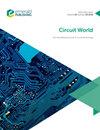A 23.3 dBm CMOS power amplifier with third-order gm cancellation linearization technique achieving OIP3 of 34 dBm
IF 0.7
4区 工程技术
Q4 ENGINEERING, ELECTRICAL & ELECTRONIC
引用次数: 1
Abstract
Purpose The purpose of this paper is to implement a highly linear 180 nm complementary metal oxide semiconductor (CMOS) power amplifier (PA) to meet the stringent linearity requirement of an long term evolution (LTE) signal with minimum trade-off to power added efficiency (PAE). Design/methodology/approach The CMOS PA is designed in a cascaded dual-stage configuration comprises a driver amplifier and a main PA. The gate voltage (VGS) of the driver amplifier is tuned to optimize its positive third-order transconductance (gm3) to be canceled with the main PA’s fixed negative gm3. The gm3 cancellation between these stages mitigates the third-order intermodulation product (IMD3) that contributes to enhanced linearity. Findings For driver’s VGS of 0.82 V with continuous wave signal, the proposed PA achieved a power gain of 14.5 dB with a peak PAE of 31.8% and a saturated output power of 23.3 dBm at 2.45 GHz. A maximum third-order output intercept point of 34 dBm is achieved at 20.2 dBm output power with a corresponding IMD3 of −33.4 dBc. When tested with a 20 MHz LTE signal, the PA delivers 19 dBm maximum linear output power for an adjacent channel leakage ratio specification of −30 dBc. Originality/value In this study, a novel cascaded gm3 cancellation technique has been implemented to achieve a maximum linear output power under modulated signals.采用三阶gm对消线性化技术的23.3 dBm CMOS功率放大器实现了34 dBm的OIP3
目的本文的目的是实现一个高度线性的180 nm互补金属氧化物半导体(CMOS)功率放大器(PA),以满足长期演进(LTE)信号的严格线性要求。设计/方法/方法CMOS PA设计为级联双级配置,包括驱动放大器和主PA。对驱动放大器的栅极电压(VGS)进行调谐,以优化其正三阶跨导(gm3),该跨导将与主PA的固定负gm3抵消。这些级之间的gm3消除减轻了有助于增强线性的三阶互调产物(IMD3)。查找驾驶员的VGS为0.82 V的连续波信号,所提出的PA实现了14.5的功率增益 dB,峰值PAE为31.8%,饱和输出功率为23.3 2.45时的dBm GHz。最大三阶输出截距点为34 在20.2时达到dBm dBm输出功率,对应的IMD3为−33.4 dBc。当用20 MHz LTE信号,PA提供19 dBm相邻信道泄漏率规格为−30时的最大线性输出功率 dBc。独创性/价值在本研究中,实现了一种新的级联gm3对消技术,以在调制信号下实现最大线性输出功率。
本文章由计算机程序翻译,如有差异,请以英文原文为准。
求助全文
约1分钟内获得全文
求助全文
来源期刊

Circuit World
工程技术-材料科学:综合
CiteScore
2.60
自引率
0.00%
发文量
33
审稿时长
>12 weeks
期刊介绍:
Circuit World is a platform for state of the art, technical papers and editorials in the areas of electronics circuit, component, assembly, and product design, manufacture, test, and use, including quality, reliability and safety. The journal comprises the multidisciplinary study of the various theories, methodologies, technologies, processes and applications relating to todays and future electronics. Circuit World provides a comprehensive and authoritative information source for research, application and current awareness purposes.
Circuit World covers a broad range of topics, including:
• Circuit theory, design methodology, analysis and simulation
• Digital, analog, microwave and optoelectronic integrated circuits
• Semiconductors, passives, connectors and sensors
• Electronic packaging of components, assemblies and products
• PCB design technologies and processes (controlled impedance, high-speed PCBs, laminates and lamination, laser processes and drilling, moulded interconnect devices, multilayer boards, optical PCBs, single- and double-sided boards, soldering and solderable finishes)
• Design for X (including manufacturability, quality, reliability, maintainability, sustainment, safety, reuse, disposal)
• Internet of Things (IoT).
 求助内容:
求助内容: 应助结果提醒方式:
应助结果提醒方式:


